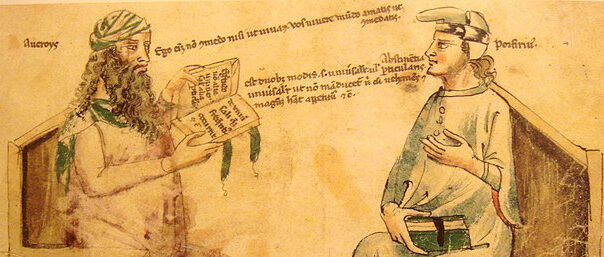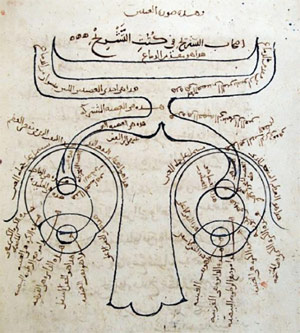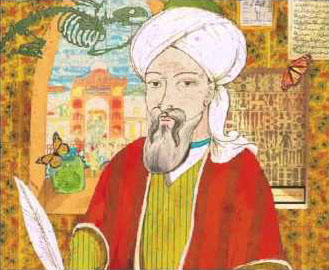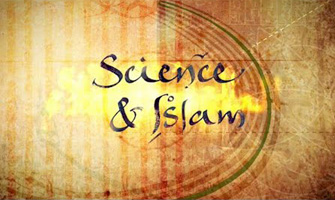
Polymaths of the Golden Age
The luminaries who contributed to the work of the House of Wisdom spoke several languages and were all polymaths, with their knowledge and abilities spanning many different fields.
A few are listed below, with links to videos where possible to give an idea of their accomplishments, individual approach and effect on the modern world.
Muḥammad ibn Mūsā al-Khwārizmī (c. 780–c. 850)
Al-Khwarizmi is the author of the first book on algebra, Kitab al-Jebr, which provided for the first time the principles and steps that could be used to solve certain algebraic equations. In fact, the word “algorithm” (the process or steps needed to solve problems) is derived from his Latin name: Algorithmus. Al-Khwarizmi’s work The Hindu Art of Reckoning played a crucial role in bringing the Hindu-Arabic numerals into widespread use in Europe, where they transformed the study of mathematics and astronomy throughout the continent.
Other mathematicians of Islam’s Golden Age further developed the field of algebra, including the Persian Omar Khayyam, a Sufi who was not only a mathematician (he was the first to write the complete theory of cubic equations) but also an astronomer, philosopher and poet, author of the famous Rubaiyat.
Watch Al-Khwarizmi: The Father of Algebra by Jim Al-Khalili (EN).
Yaqub ibn Ishaq al-Kindi of Basra (805–873; Latin name Alcindi)
Al-Kindi supervised the translation of numerous texts from Greek to Arabic; he was known as the “Philosopher of the Arabs,” but also wrote on mathematics, geography, music, medicine, astronomy and even cryptography, among other disciplines. Al-Kindi applied philosophical thinking to Islam, emphasizing the importance of studying Aristotelian philosophy and not rejecting it, insisting that “We ought not to be embarrassed about appreciating the truth and obtaining it wherever it comes from, even if it comes from races distant and nations different from us. Nothing should be dearer to the seeker of truth than the truth itself, and there is no deterioration of the truth, nor belittling either of one who speaks it or conveys it.”
Al Farabi (870–950; Latin name Abunaser)
After Al-Kindi, Al-Farabi continued the work of assimilating Greek philosophy into Islamic thinking and, for his efforts, came to be known as “the Second Teacher,” after Aristotle.
“Man is a part of the world, and if we wish to understand his aim and activity and use and place, then we must first know the purpose of the whole world, so that it will become clear to us what man’s aim is, as well as the fact that man is necessarily a part of the world, in that his aim is necessary for realizing the ultimate purpose of the whole world. Therefore, if we wish to know the object toward which we should strive, we must know the aim of man and the human perfection on account of which we should strive.” (Quoted by David C. Reisman, “Al-Farabi and the philosophical curriculum,” in The Cambridge Companion to Arabic Philosophy.)
Abu Bakr Muhammad ibn Zakariyya al-Razi of Persia (865–925; Latin name Rhazes)
Medicine was another field that saw great achievements. Al-Razi (known in the West as Rhazes) was the most famous physician of his time and was also a chemist and philosopher. He wrote the Kitab al-Hawi (Liber continens) and a monograph on smallpox and measles, which remained two of the most important works on medicine in Europe for several centuries. Al-Razi drew inspiration from the Greek greats Galen and Hippocrates, but he did so critically, even writing a book called Doubts about Galen, in which he questioned and critically evaluated some of Galen’s ideas. He was an opponent of quacks and a champion of the scientific method, conducting one of the earliest clinical trials in history, in which he investigated whether bloodletting could treat meningitis.
In Baghdad, Al-Razi was treating patients with mental illness—at a time when the mentally ill in Christian Europe were viewed as possessed by the devil—earning him the accolade “father of psychology and psychotherapy.” He was a pioneer chemist, moving away from the Greek philosophical meditations reflected in the work of his predecessor Jabir ibn Hayyan (known in the West as Geber the Alchemist). Al-Razi produced one of the earliest classifications of the chemical elements. He was a freethinker who once commented, “If the people of religion are asked about the proof for the soundness of their religion, they flare up, get angry, and spill the blood of whoever confronts them with this question,” and asked, “How can anyone think philosophically while committed to old wives’ tales, founded on contradictions, obdurate ignorance, and dogmatism?”
Abū Ali al-Hassan ibn al-Haytham (965–c. 1040; Latin name: Alhazen)
In 969 CE Al-Hakim, one of the Fatimid Caliphate (Shia rulers who claimed their descent from Fatima, daughter of the Prophet Muhammad) built the city of Cairo. With the Al-Azhar Mosque and university at its heart, Cairo became another center of learning. The Arab polymath Abū Ali al-Hassan ibn al-Haytham went there from Basra in about 1000. He is regarded as one of history’s greatest physicists, ranked between Archimedes and Isaac Newton. Al-Haytham’s most famous work, Kitab al-Manazir (The Book of Optics), shaped our understanding of vision, optics and light.

Al-Haytham worked on optics and astronomy, including the optics of vision (though he didn’t carry his thinking far enough to show how the inverted image forms on the retina). Prior to him, it had been thought that vision required light being emitted by the eye, an idea he disproved with the help of observation and logic. Like others of his time, Al-Haytham was geocentric in his thinking, believing the Earth to be the center of the universe; nevertheless, his emphasis on the scientific method has led many to consider him the first true scientist. One of his seminal contributions was to ground astronomy in a mathematical foundation, emphasizing planetary motion in terms of mathematics alone, without recourse to any philosophy or ideology. Al-Haytham’s stance on facts is evident: “The duty of the man who investigates the writings of scientists, if learning the truth is his goal, is to make himself an enemy of all that he reads, and … attack it from every side. He should also suspect himself as he performs his critical examination of it, so that he may avoid falling into either prejudice or leniency.”
Watch Ibn Al-Haytham (Alhazen)—Optics: The True Nature of Light by Jim Al-Khalili (EN).
Abū Rayhān al-Bīrūni (973–c.1050; Latin name Alberonius)
Al-Biruni was a philosopher, astronomer, mathematician, anthropologist and geographer, and was the author of a great historical text, The Chronology of Ancient Nations, a book still regarded as one of the greatest sources of medieval history ever written. He spent much of his life in Ghazni, the capital of the Ghaznavid dynasty, in modern-day Afghanistan, and became court astrologer to Sultan Mahmud of Ghazni, whom he accompanied on invasions into India.
Al-Biruni found a way to measure the circumference of the Earth more accurately than it had ever been measured before, within one percent of the correct value, and he did so in a very clever way, as explained in The House of Wisdom (pp. 184–186). He also noted that the available evidence could be used to make a case for the Earth revolving around the sun just as much as for the reverse. Al-Biruni defended scientific thinking from the “extremist” who would “stamp out science as atheistic” so as to make “ignoramuses, hate the sciences” and lead to “complete destruction of science and scientists.” With works on comparative religion and different cultures—for example, that of India where he studied Indian history and the Hindu faith—he is considered history’s first anthropologist. Such was his prestige that the first half of the eleventh century was acknowledged as the “Age of Al-Biruni.”
“The stubborn critic would say: ‘What is the benefit of these sciences?’ He does not know the virtue that distinguishes mankind from all the animals: it is knowledge, in general, which is pursued solely by man, and which is pursued for the sake of knowledge itself, because its acquisition is truly delightful, and is unlike the pleasures desirable from other pursuits. For the good cannot be brought forth, and cannot be avoided, except by knowledge. What benefit then is more vivid? What use is more abundant?” (Al-Biruni, quoted by Jim Al-Khalili in Pathfinders: The Golden Age of Arabic Science)
Abu Ali al-Husain ibn Sina (980–1037; Latin name Avicenna)


UNBOXED: Avicenna’s Floating Man & Descartes’ Deceiving Demon
Ibn Sina is probably the most famous Islamic scholar in history, and is considered the father of modern medicine. His Canon of Medicine, a medical encyclopedia, was a standard textbook in both the Arab world and Europe for 600 years. Another famous work, The Book of Healing, dealt with science and philosophy and was influenced by Greek and Hellenistic thinkers as well as by earlier Persian and Arab scientists and philosophers, such as al-Biruni, Al-Farabi and Al-Kindi. Ibn Sina more than any other scholar, helped spread the ideas of Neoplatonism within the Islamic world. He was “in the Arabic culture the most effective promoter of Greek philosophy” (Laughlin, The Aristotle Adventure, 117). 600 years before Descartes’ famous “I think therefore I am,” Ibn Sina argued that consciousness, our awareness, is the last thing and the most essential part of ourselves. In his “floating man” thought experiment (see video), he demonstrated that even without sight, sensation, memory and imagination, we are conscious and can be said to exist. Ibn Sina was also a mathematician, whose pioneer work on equations and propositional algebra would influence Descartes, Newton and Leibniz.
Ibn Sina’s impact was felt not only in the Arabic world but in Christian Europe as well, overshadowed only by that of Averroes. Ibn Sina was influenced by Aristotle and is considered nearly as important in Western Philosophy as Aristotle. As noted in the Introduction to The Cambridge Companion to Arabic Philosophy, “Like Kant in the German tradition or Plato and Aristotle in the Greek tradition, Avicenna significantly influenced everything that came after him in the Arabic tradition.”
Muhammad al-Ghazali of Khurasan (1058–1111; Latin name Algazel)
Al-Ghazali is considered one of the most prominent and influential Muslim thinkers. A philosopher, theologian, jurist and mystic, he was able to reconcile Islam with intellectualism at a time when Islam was threatened by hierarchical clerics (which were forbidden in Islam) and an affluent intelligentsia unable to accept their dicta. Such books of Al-Ghazali’s as the Alchemy of Happiness and The Niche for Lights are read to this day.
“In under fifty years after their composition, his books were exerting a tremendous influence upon Jewish and Christian scholasticism. He not only anticipated in a remarkable fashion John Bunyan’s Holy War and Pilgrim’s Progress, but influenced Ramón Marti, Thomas Aquinas and Pascal, as well as numerous more modern thinkers. … Ghazali, by using the Sufi concept that all religious and psychological activity is essentially of the same nature, representing a continuing tradition which can be furthered by certain individuals, arrived at the position where he could represent both the mystical and the theological worlds perfectly within their own contexts.” (Idries Shah, The Sufis)
Watch The Science of the Stars – Astronomy in the Golden Age and Today
In the series: The Journey of Classical Greek Culture to the West
Further Reading »
External Stories and Videos


Science & Islam
BBC full series with Jim Al-Khalili
The history of Islamic science and it’s subsequent spread through Europe.
